Strategic Business Plan: Proposal for Biotic Axis Organic Farming
VerifiedAdded on 2019/10/31
|94
|16428
|38
Project
AI Summary
This project presents a comprehensive strategic business plan proposal for Biotic Axis, focusing on organic rooftop farming in Chennai. The plan includes an introduction outlining the rationale for the business idea, scenario chosen, aims, and objectives, followed by an extensive literature review covering the organic urban farming industry, market analysis, and marketing mix. The research methodology details the methods undertaken, including research philosophy, approach, design, and data collection. The results and discussion section provides a strategic analysis incorporating value chain, SWOT, product life cycle, BCG matrix, generic strategy, balanced scorecard, and PEST analysis. The plan also covers the selection of strategies for success, development of an appropriate business model, and findings from data collected. Finally, the conclusion summarizes the business plan schedule, discusses critical success and failure factors, and provides recommendations. The project aims to promote rooftop organic gardening in Chennai, addressing environmental sustainability and economic self-sufficiency.
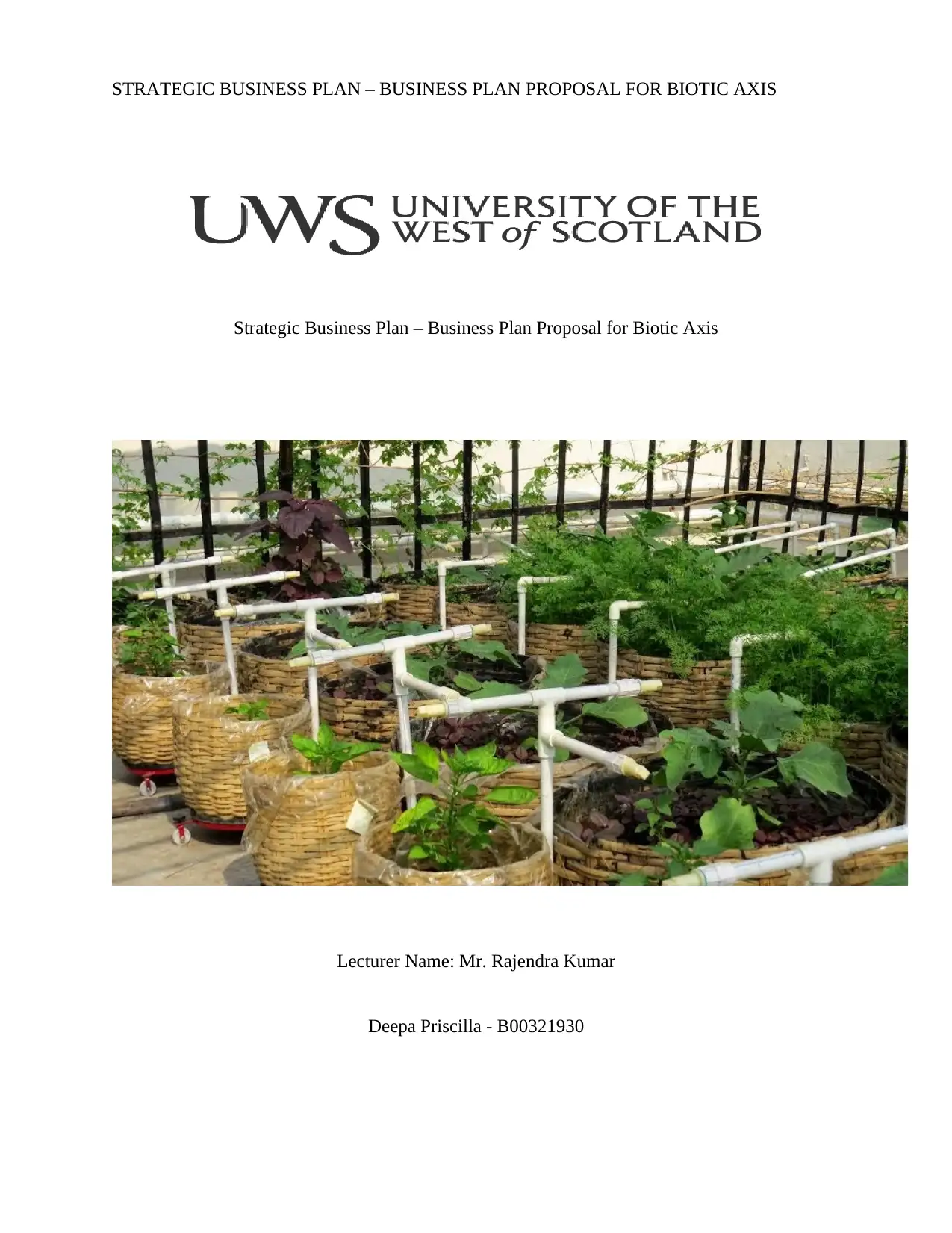
STRATEGIC BUSINESS PLAN – BUSINESS PLAN PROPOSAL FOR BIOTIC AXIS
Strategic Business Plan – Business Plan Proposal for Biotic Axis
Lecturer Name: Mr. Rajendra Kumar
Deepa Priscilla - B00321930
Strategic Business Plan – Business Plan Proposal for Biotic Axis
Lecturer Name: Mr. Rajendra Kumar
Deepa Priscilla - B00321930
Paraphrase This Document
Need a fresh take? Get an instant paraphrase of this document with our AI Paraphraser
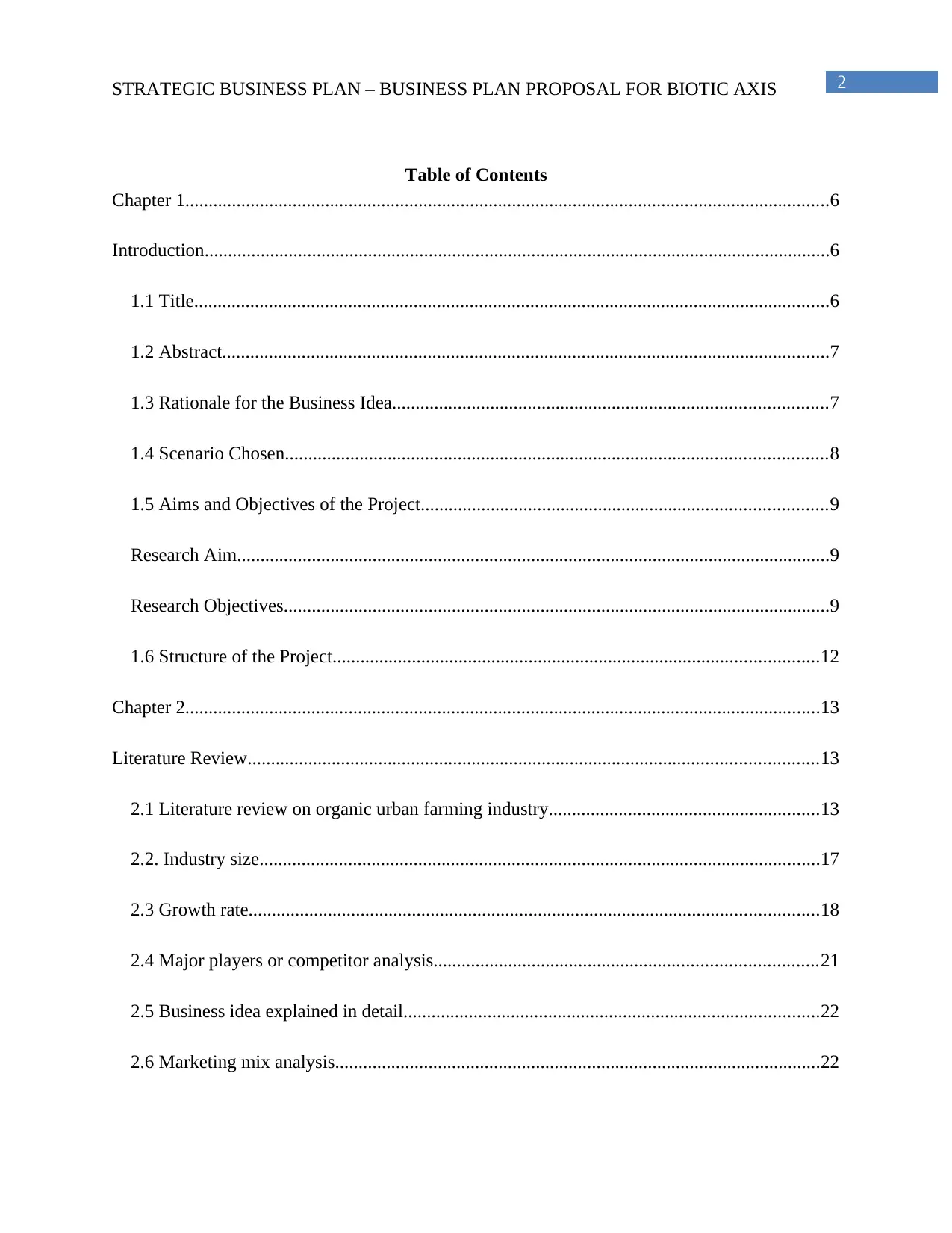
2STRATEGIC BUSINESS PLAN – BUSINESS PLAN PROPOSAL FOR BIOTIC AXIS
Table of Contents
Chapter 1..........................................................................................................................................6
Introduction......................................................................................................................................6
1.1 Title........................................................................................................................................6
1.2 Abstract..................................................................................................................................7
1.3 Rationale for the Business Idea.............................................................................................7
1.4 Scenario Chosen....................................................................................................................8
1.5 Aims and Objectives of the Project.......................................................................................9
Research Aim...............................................................................................................................9
Research Objectives.....................................................................................................................9
1.6 Structure of the Project........................................................................................................12
Chapter 2........................................................................................................................................13
Literature Review..........................................................................................................................13
2.1 Literature review on organic urban farming industry..........................................................13
2.2. Industry size........................................................................................................................17
2.3 Growth rate..........................................................................................................................18
2.4 Major players or competitor analysis..................................................................................21
2.5 Business idea explained in detail.........................................................................................22
2.6 Marketing mix analysis........................................................................................................22
Table of Contents
Chapter 1..........................................................................................................................................6
Introduction......................................................................................................................................6
1.1 Title........................................................................................................................................6
1.2 Abstract..................................................................................................................................7
1.3 Rationale for the Business Idea.............................................................................................7
1.4 Scenario Chosen....................................................................................................................8
1.5 Aims and Objectives of the Project.......................................................................................9
Research Aim...............................................................................................................................9
Research Objectives.....................................................................................................................9
1.6 Structure of the Project........................................................................................................12
Chapter 2........................................................................................................................................13
Literature Review..........................................................................................................................13
2.1 Literature review on organic urban farming industry..........................................................13
2.2. Industry size........................................................................................................................17
2.3 Growth rate..........................................................................................................................18
2.4 Major players or competitor analysis..................................................................................21
2.5 Business idea explained in detail.........................................................................................22
2.6 Marketing mix analysis........................................................................................................22
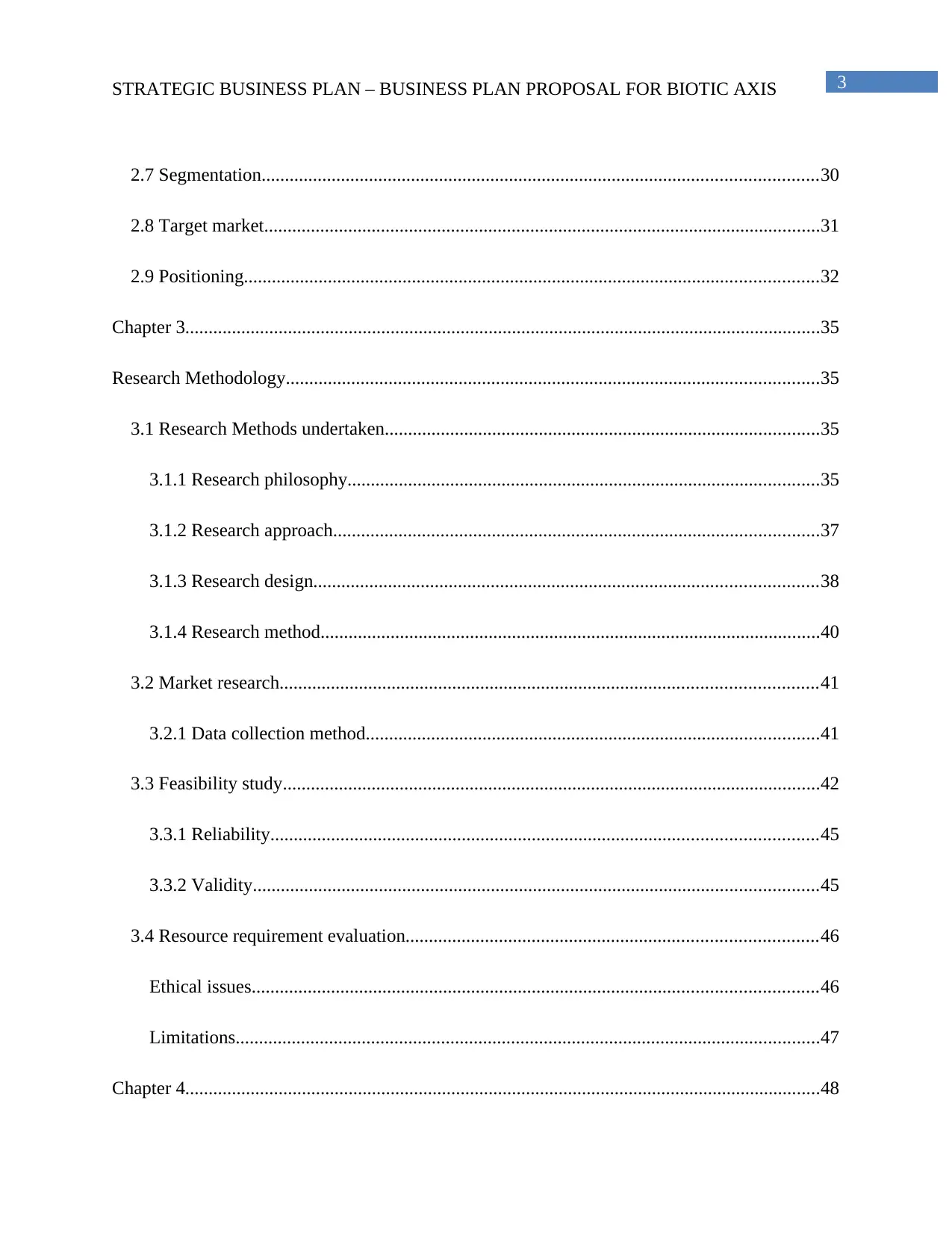
3STRATEGIC BUSINESS PLAN – BUSINESS PLAN PROPOSAL FOR BIOTIC AXIS
2.7 Segmentation.......................................................................................................................30
2.8 Target market.......................................................................................................................31
2.9 Positioning...........................................................................................................................32
Chapter 3........................................................................................................................................35
Research Methodology..................................................................................................................35
3.1 Research Methods undertaken.............................................................................................35
3.1.1 Research philosophy.....................................................................................................35
3.1.2 Research approach........................................................................................................37
3.1.3 Research design............................................................................................................38
3.1.4 Research method...........................................................................................................40
3.2 Market research...................................................................................................................41
3.2.1 Data collection method.................................................................................................41
3.3 Feasibility study...................................................................................................................42
3.3.1 Reliability.....................................................................................................................45
3.3.2 Validity.........................................................................................................................45
3.4 Resource requirement evaluation........................................................................................46
Ethical issues.........................................................................................................................46
Limitations.............................................................................................................................47
Chapter 4........................................................................................................................................48
2.7 Segmentation.......................................................................................................................30
2.8 Target market.......................................................................................................................31
2.9 Positioning...........................................................................................................................32
Chapter 3........................................................................................................................................35
Research Methodology..................................................................................................................35
3.1 Research Methods undertaken.............................................................................................35
3.1.1 Research philosophy.....................................................................................................35
3.1.2 Research approach........................................................................................................37
3.1.3 Research design............................................................................................................38
3.1.4 Research method...........................................................................................................40
3.2 Market research...................................................................................................................41
3.2.1 Data collection method.................................................................................................41
3.3 Feasibility study...................................................................................................................42
3.3.1 Reliability.....................................................................................................................45
3.3.2 Validity.........................................................................................................................45
3.4 Resource requirement evaluation........................................................................................46
Ethical issues.........................................................................................................................46
Limitations.............................................................................................................................47
Chapter 4........................................................................................................................................48
⊘ This is a preview!⊘
Do you want full access?
Subscribe today to unlock all pages.

Trusted by 1+ million students worldwide
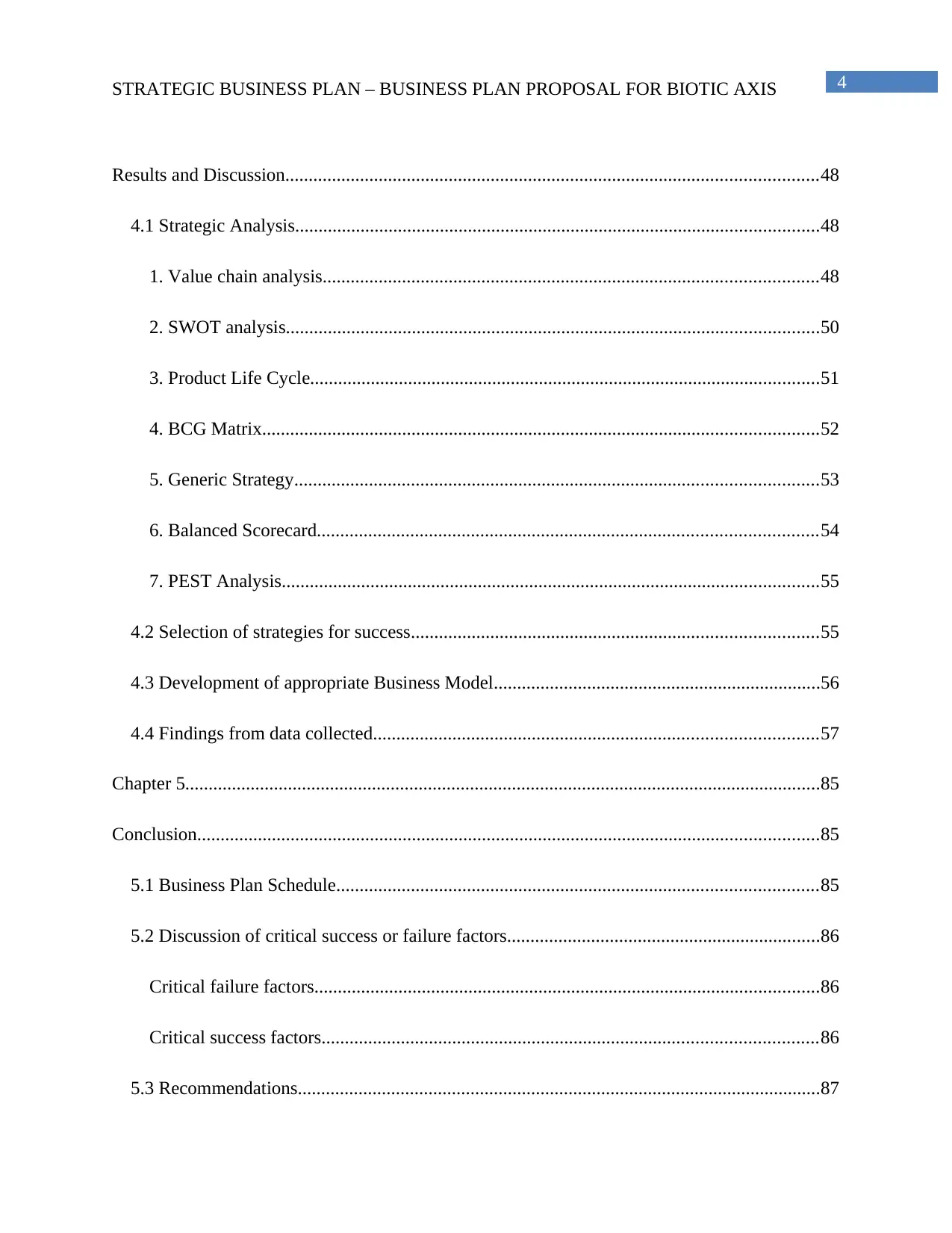
4STRATEGIC BUSINESS PLAN – BUSINESS PLAN PROPOSAL FOR BIOTIC AXIS
Results and Discussion..................................................................................................................48
4.1 Strategic Analysis................................................................................................................48
1. Value chain analysis..........................................................................................................48
2. SWOT analysis..................................................................................................................50
3. Product Life Cycle.............................................................................................................51
4. BCG Matrix.......................................................................................................................52
5. Generic Strategy................................................................................................................53
6. Balanced Scorecard...........................................................................................................54
7. PEST Analysis...................................................................................................................55
4.2 Selection of strategies for success.......................................................................................55
4.3 Development of appropriate Business Model......................................................................56
4.4 Findings from data collected...............................................................................................57
Chapter 5........................................................................................................................................85
Conclusion.....................................................................................................................................85
5.1 Business Plan Schedule.......................................................................................................85
5.2 Discussion of critical success or failure factors...................................................................86
Critical failure factors............................................................................................................86
Critical success factors..........................................................................................................86
5.3 Recommendations................................................................................................................87
Results and Discussion..................................................................................................................48
4.1 Strategic Analysis................................................................................................................48
1. Value chain analysis..........................................................................................................48
2. SWOT analysis..................................................................................................................50
3. Product Life Cycle.............................................................................................................51
4. BCG Matrix.......................................................................................................................52
5. Generic Strategy................................................................................................................53
6. Balanced Scorecard...........................................................................................................54
7. PEST Analysis...................................................................................................................55
4.2 Selection of strategies for success.......................................................................................55
4.3 Development of appropriate Business Model......................................................................56
4.4 Findings from data collected...............................................................................................57
Chapter 5........................................................................................................................................85
Conclusion.....................................................................................................................................85
5.1 Business Plan Schedule.......................................................................................................85
5.2 Discussion of critical success or failure factors...................................................................86
Critical failure factors............................................................................................................86
Critical success factors..........................................................................................................86
5.3 Recommendations................................................................................................................87
Paraphrase This Document
Need a fresh take? Get an instant paraphrase of this document with our AI Paraphraser

5STRATEGIC BUSINESS PLAN – BUSINESS PLAN PROPOSAL FOR BIOTIC AXIS
References and Bibliography.........................................................................................................89
References and Bibliography.........................................................................................................89

6STRATEGIC BUSINESS PLAN – BUSINESS PLAN PROPOSAL FOR BIOTIC AXIS
Chapter 1
Introduction
1.1 Title
Agriculture is one of the most important industries in almost every country especially in
India. Agriculture assists human beings in growing food and comprises of farming and growing
crops. The different aspects of agriculture act as contributing factors to the development of a
country.
The study focuses on the importance of rooftop organic farming and the adopted methods
in order to promote it in the community. It is expected that rooftop farming will become more
and more accepted in the coming times, as it will help in the sustainability of the environment as
a whole. Every house in which it would be done would not only become sustainable in producing
its own healthy food, it could also create carbon credits as it is a extremely water competent and
very low energy agricultural scheme which has been shaped. The cost of buying the vegetables
will be reduced. The wastage cost will also not be incurred if more and more adopt this method
of farming in their houses. Also by growing fresh vegetables on the rooftop, the unutilized
rooftops can be covered with a natural green cover, which is responsible for considerably
bringing down the temperature of the building therefore reducing the power consumption of the
building. In addition, the containers used for growing the organic vegetables on the rooftop can
be used for catching the rainfall and harvesting it (Mandel 2013).
Chapter 1
Introduction
1.1 Title
Agriculture is one of the most important industries in almost every country especially in
India. Agriculture assists human beings in growing food and comprises of farming and growing
crops. The different aspects of agriculture act as contributing factors to the development of a
country.
The study focuses on the importance of rooftop organic farming and the adopted methods
in order to promote it in the community. It is expected that rooftop farming will become more
and more accepted in the coming times, as it will help in the sustainability of the environment as
a whole. Every house in which it would be done would not only become sustainable in producing
its own healthy food, it could also create carbon credits as it is a extremely water competent and
very low energy agricultural scheme which has been shaped. The cost of buying the vegetables
will be reduced. The wastage cost will also not be incurred if more and more adopt this method
of farming in their houses. Also by growing fresh vegetables on the rooftop, the unutilized
rooftops can be covered with a natural green cover, which is responsible for considerably
bringing down the temperature of the building therefore reducing the power consumption of the
building. In addition, the containers used for growing the organic vegetables on the rooftop can
be used for catching the rainfall and harvesting it (Mandel 2013).
⊘ This is a preview!⊘
Do you want full access?
Subscribe today to unlock all pages.

Trusted by 1+ million students worldwide
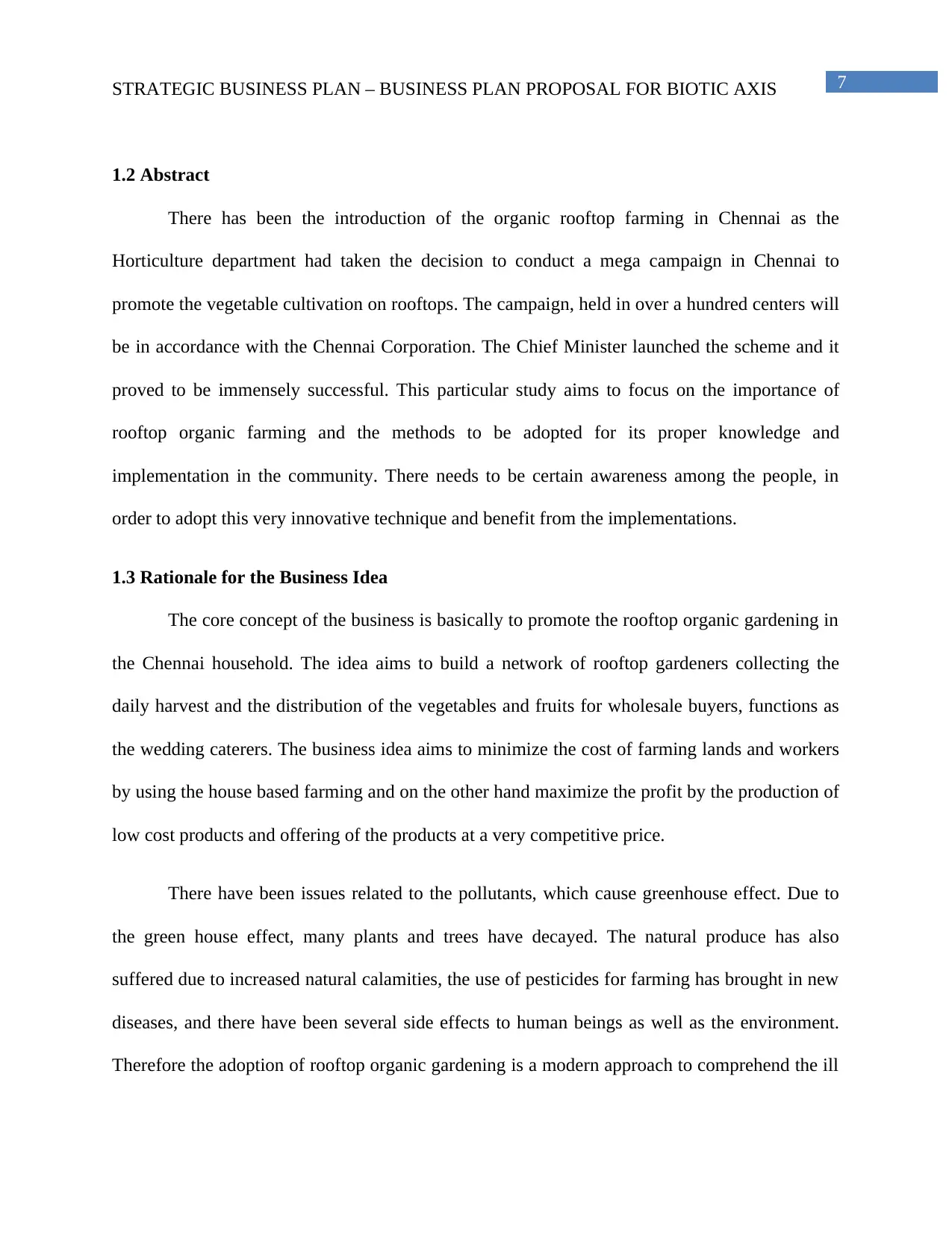
7STRATEGIC BUSINESS PLAN – BUSINESS PLAN PROPOSAL FOR BIOTIC AXIS
1.2 Abstract
There has been the introduction of the organic rooftop farming in Chennai as the
Horticulture department had taken the decision to conduct a mega campaign in Chennai to
promote the vegetable cultivation on rooftops. The campaign, held in over a hundred centers will
be in accordance with the Chennai Corporation. The Chief Minister launched the scheme and it
proved to be immensely successful. This particular study aims to focus on the importance of
rooftop organic farming and the methods to be adopted for its proper knowledge and
implementation in the community. There needs to be certain awareness among the people, in
order to adopt this very innovative technique and benefit from the implementations.
1.3 Rationale for the Business Idea
The core concept of the business is basically to promote the rooftop organic gardening in
the Chennai household. The idea aims to build a network of rooftop gardeners collecting the
daily harvest and the distribution of the vegetables and fruits for wholesale buyers, functions as
the wedding caterers. The business idea aims to minimize the cost of farming lands and workers
by using the house based farming and on the other hand maximize the profit by the production of
low cost products and offering of the products at a very competitive price.
There have been issues related to the pollutants, which cause greenhouse effect. Due to
the green house effect, many plants and trees have decayed. The natural produce has also
suffered due to increased natural calamities, the use of pesticides for farming has brought in new
diseases, and there have been several side effects to human beings as well as the environment.
Therefore the adoption of rooftop organic gardening is a modern approach to comprehend the ill
1.2 Abstract
There has been the introduction of the organic rooftop farming in Chennai as the
Horticulture department had taken the decision to conduct a mega campaign in Chennai to
promote the vegetable cultivation on rooftops. The campaign, held in over a hundred centers will
be in accordance with the Chennai Corporation. The Chief Minister launched the scheme and it
proved to be immensely successful. This particular study aims to focus on the importance of
rooftop organic farming and the methods to be adopted for its proper knowledge and
implementation in the community. There needs to be certain awareness among the people, in
order to adopt this very innovative technique and benefit from the implementations.
1.3 Rationale for the Business Idea
The core concept of the business is basically to promote the rooftop organic gardening in
the Chennai household. The idea aims to build a network of rooftop gardeners collecting the
daily harvest and the distribution of the vegetables and fruits for wholesale buyers, functions as
the wedding caterers. The business idea aims to minimize the cost of farming lands and workers
by using the house based farming and on the other hand maximize the profit by the production of
low cost products and offering of the products at a very competitive price.
There have been issues related to the pollutants, which cause greenhouse effect. Due to
the green house effect, many plants and trees have decayed. The natural produce has also
suffered due to increased natural calamities, the use of pesticides for farming has brought in new
diseases, and there have been several side effects to human beings as well as the environment.
Therefore the adoption of rooftop organic gardening is a modern approach to comprehend the ill
Paraphrase This Document
Need a fresh take? Get an instant paraphrase of this document with our AI Paraphraser
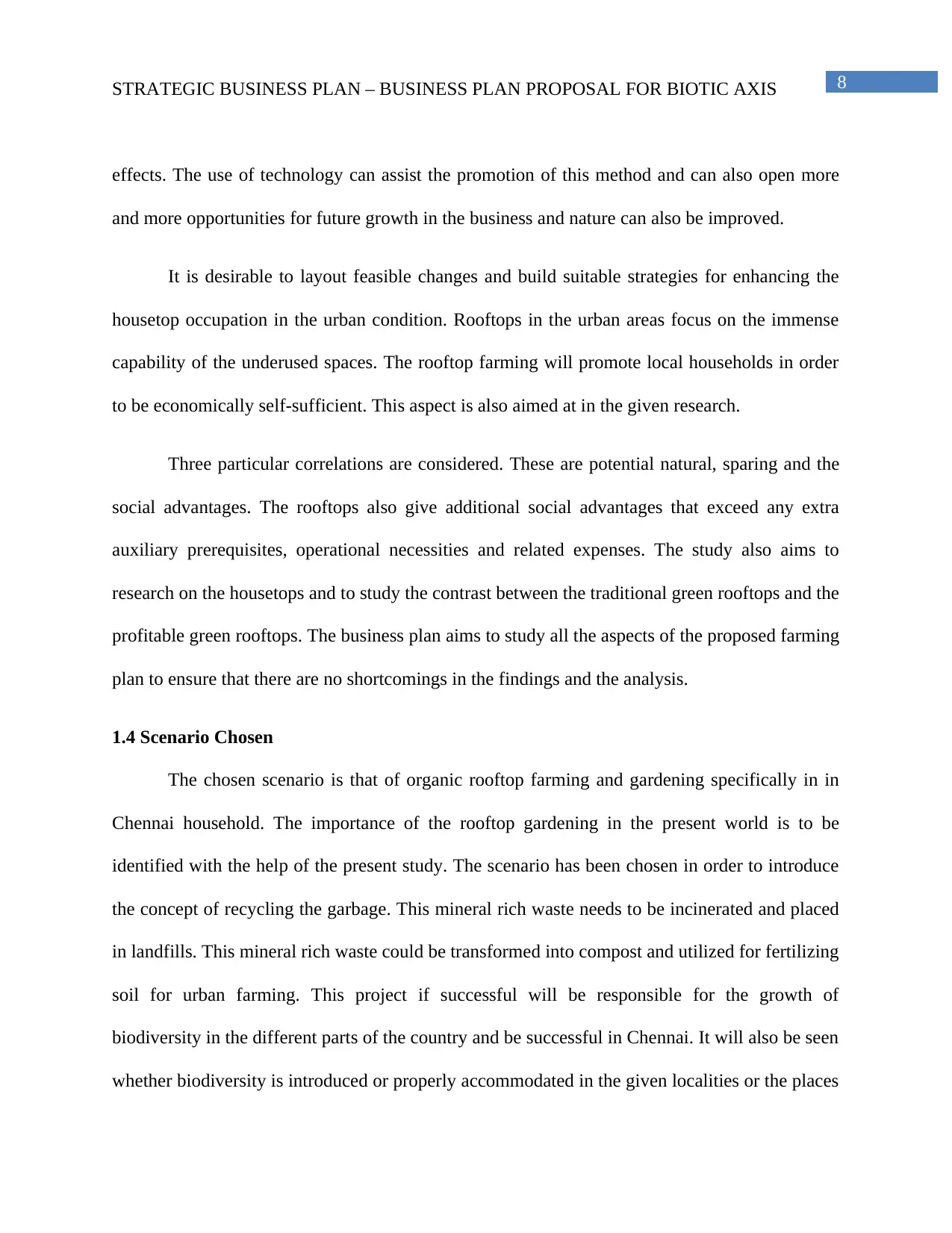
8STRATEGIC BUSINESS PLAN – BUSINESS PLAN PROPOSAL FOR BIOTIC AXIS
effects. The use of technology can assist the promotion of this method and can also open more
and more opportunities for future growth in the business and nature can also be improved.
It is desirable to layout feasible changes and build suitable strategies for enhancing the
housetop occupation in the urban condition. Rooftops in the urban areas focus on the immense
capability of the underused spaces. The rooftop farming will promote local households in order
to be economically self-sufficient. This aspect is also aimed at in the given research.
Three particular correlations are considered. These are potential natural, sparing and the
social advantages. The rooftops also give additional social advantages that exceed any extra
auxiliary prerequisites, operational necessities and related expenses. The study also aims to
research on the housetops and to study the contrast between the traditional green rooftops and the
profitable green rooftops. The business plan aims to study all the aspects of the proposed farming
plan to ensure that there are no shortcomings in the findings and the analysis.
1.4 Scenario Chosen
The chosen scenario is that of organic rooftop farming and gardening specifically in in
Chennai household. The importance of the rooftop gardening in the present world is to be
identified with the help of the present study. The scenario has been chosen in order to introduce
the concept of recycling the garbage. This mineral rich waste needs to be incinerated and placed
in landfills. This mineral rich waste could be transformed into compost and utilized for fertilizing
soil for urban farming. This project if successful will be responsible for the growth of
biodiversity in the different parts of the country and be successful in Chennai. It will also be seen
whether biodiversity is introduced or properly accommodated in the given localities or the places
effects. The use of technology can assist the promotion of this method and can also open more
and more opportunities for future growth in the business and nature can also be improved.
It is desirable to layout feasible changes and build suitable strategies for enhancing the
housetop occupation in the urban condition. Rooftops in the urban areas focus on the immense
capability of the underused spaces. The rooftop farming will promote local households in order
to be economically self-sufficient. This aspect is also aimed at in the given research.
Three particular correlations are considered. These are potential natural, sparing and the
social advantages. The rooftops also give additional social advantages that exceed any extra
auxiliary prerequisites, operational necessities and related expenses. The study also aims to
research on the housetops and to study the contrast between the traditional green rooftops and the
profitable green rooftops. The business plan aims to study all the aspects of the proposed farming
plan to ensure that there are no shortcomings in the findings and the analysis.
1.4 Scenario Chosen
The chosen scenario is that of organic rooftop farming and gardening specifically in in
Chennai household. The importance of the rooftop gardening in the present world is to be
identified with the help of the present study. The scenario has been chosen in order to introduce
the concept of recycling the garbage. This mineral rich waste needs to be incinerated and placed
in landfills. This mineral rich waste could be transformed into compost and utilized for fertilizing
soil for urban farming. This project if successful will be responsible for the growth of
biodiversity in the different parts of the country and be successful in Chennai. It will also be seen
whether biodiversity is introduced or properly accommodated in the given localities or the places
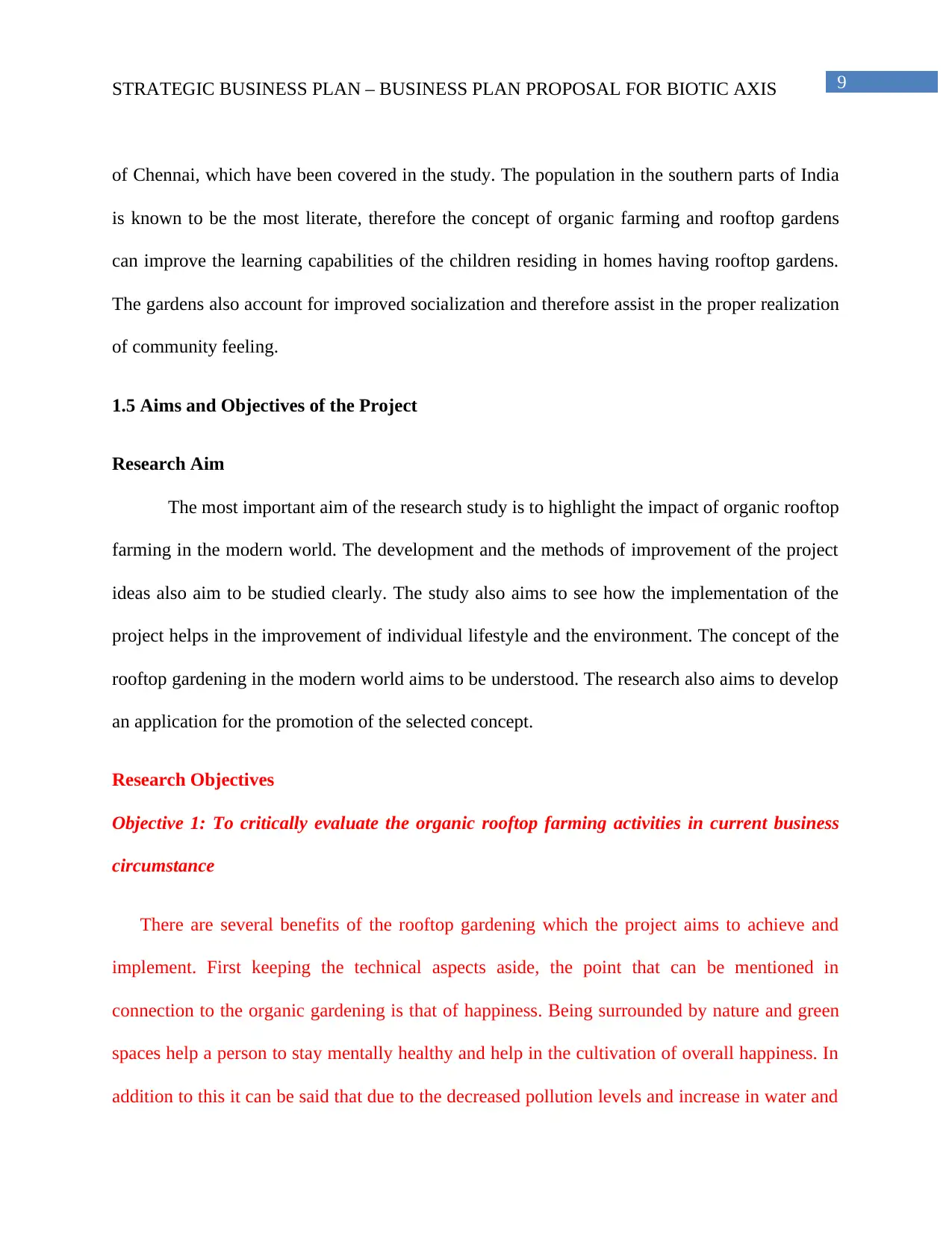
9STRATEGIC BUSINESS PLAN – BUSINESS PLAN PROPOSAL FOR BIOTIC AXIS
of Chennai, which have been covered in the study. The population in the southern parts of India
is known to be the most literate, therefore the concept of organic farming and rooftop gardens
can improve the learning capabilities of the children residing in homes having rooftop gardens.
The gardens also account for improved socialization and therefore assist in the proper realization
of community feeling.
1.5 Aims and Objectives of the Project
Research Aim
The most important aim of the research study is to highlight the impact of organic rooftop
farming in the modern world. The development and the methods of improvement of the project
ideas also aim to be studied clearly. The study also aims to see how the implementation of the
project helps in the improvement of individual lifestyle and the environment. The concept of the
rooftop gardening in the modern world aims to be understood. The research also aims to develop
an application for the promotion of the selected concept.
Research Objectives
Objective 1: To critically evaluate the organic rooftop farming activities in current business
circumstance
There are several benefits of the rooftop gardening which the project aims to achieve and
implement. First keeping the technical aspects aside, the point that can be mentioned in
connection to the organic gardening is that of happiness. Being surrounded by nature and green
spaces help a person to stay mentally healthy and help in the cultivation of overall happiness. In
addition to this it can be said that due to the decreased pollution levels and increase in water and
of Chennai, which have been covered in the study. The population in the southern parts of India
is known to be the most literate, therefore the concept of organic farming and rooftop gardens
can improve the learning capabilities of the children residing in homes having rooftop gardens.
The gardens also account for improved socialization and therefore assist in the proper realization
of community feeling.
1.5 Aims and Objectives of the Project
Research Aim
The most important aim of the research study is to highlight the impact of organic rooftop
farming in the modern world. The development and the methods of improvement of the project
ideas also aim to be studied clearly. The study also aims to see how the implementation of the
project helps in the improvement of individual lifestyle and the environment. The concept of the
rooftop gardening in the modern world aims to be understood. The research also aims to develop
an application for the promotion of the selected concept.
Research Objectives
Objective 1: To critically evaluate the organic rooftop farming activities in current business
circumstance
There are several benefits of the rooftop gardening which the project aims to achieve and
implement. First keeping the technical aspects aside, the point that can be mentioned in
connection to the organic gardening is that of happiness. Being surrounded by nature and green
spaces help a person to stay mentally healthy and help in the cultivation of overall happiness. In
addition to this it can be said that due to the decreased pollution levels and increase in water and
⊘ This is a preview!⊘
Do you want full access?
Subscribe today to unlock all pages.

Trusted by 1+ million students worldwide
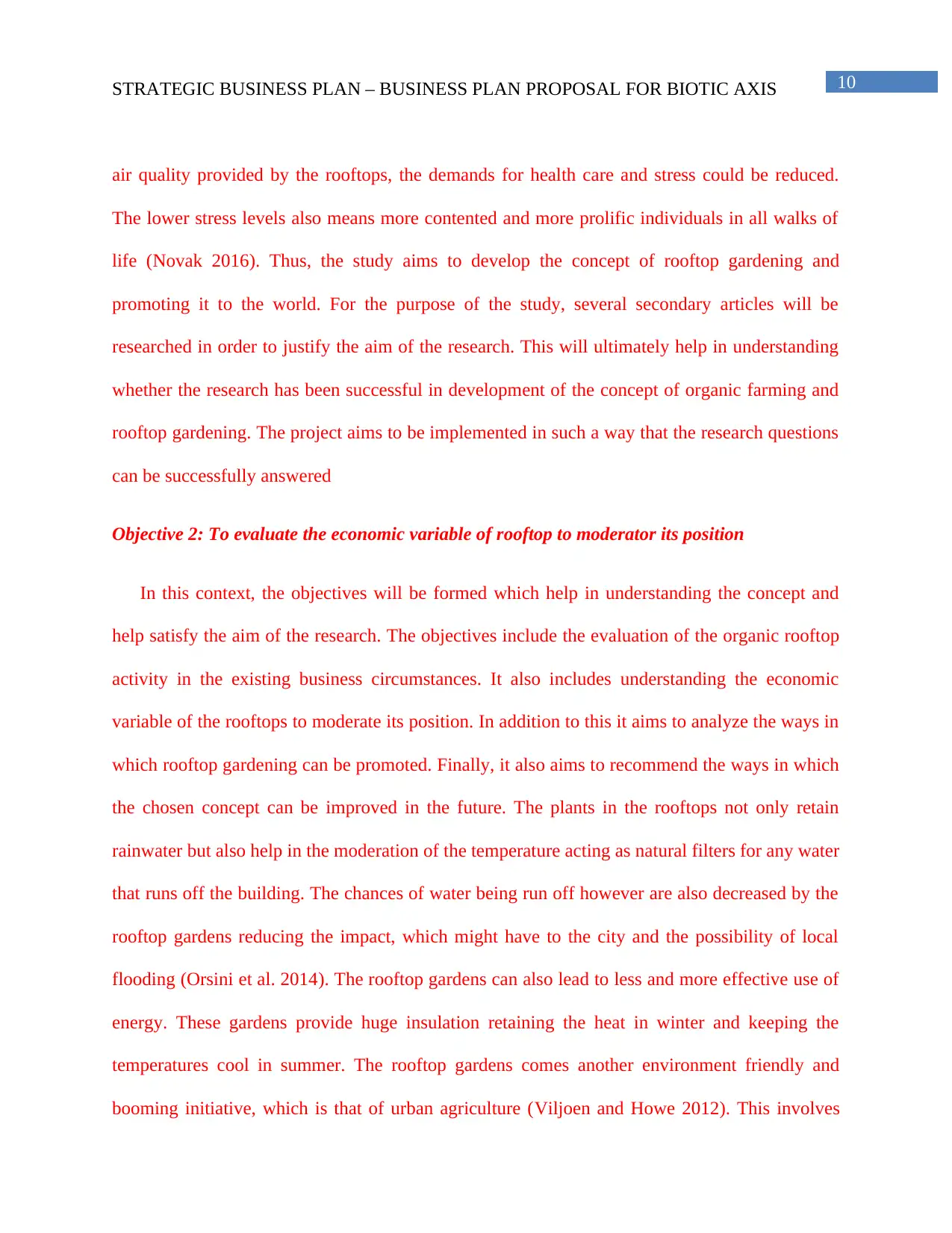
10STRATEGIC BUSINESS PLAN – BUSINESS PLAN PROPOSAL FOR BIOTIC AXIS
air quality provided by the rooftops, the demands for health care and stress could be reduced.
The lower stress levels also means more contented and more prolific individuals in all walks of
life (Novak 2016). Thus, the study aims to develop the concept of rooftop gardening and
promoting it to the world. For the purpose of the study, several secondary articles will be
researched in order to justify the aim of the research. This will ultimately help in understanding
whether the research has been successful in development of the concept of organic farming and
rooftop gardening. The project aims to be implemented in such a way that the research questions
can be successfully answered
Objective 2: To evaluate the economic variable of rooftop to moderator its position
In this context, the objectives will be formed which help in understanding the concept and
help satisfy the aim of the research. The objectives include the evaluation of the organic rooftop
activity in the existing business circumstances. It also includes understanding the economic
variable of the rooftops to moderate its position. In addition to this it aims to analyze the ways in
which rooftop gardening can be promoted. Finally, it also aims to recommend the ways in which
the chosen concept can be improved in the future. The plants in the rooftops not only retain
rainwater but also help in the moderation of the temperature acting as natural filters for any water
that runs off the building. The chances of water being run off however are also decreased by the
rooftop gardens reducing the impact, which might have to the city and the possibility of local
flooding (Orsini et al. 2014). The rooftop gardens can also lead to less and more effective use of
energy. These gardens provide huge insulation retaining the heat in winter and keeping the
temperatures cool in summer. The rooftop gardens comes another environment friendly and
booming initiative, which is that of urban agriculture (Viljoen and Howe 2012). This involves
air quality provided by the rooftops, the demands for health care and stress could be reduced.
The lower stress levels also means more contented and more prolific individuals in all walks of
life (Novak 2016). Thus, the study aims to develop the concept of rooftop gardening and
promoting it to the world. For the purpose of the study, several secondary articles will be
researched in order to justify the aim of the research. This will ultimately help in understanding
whether the research has been successful in development of the concept of organic farming and
rooftop gardening. The project aims to be implemented in such a way that the research questions
can be successfully answered
Objective 2: To evaluate the economic variable of rooftop to moderator its position
In this context, the objectives will be formed which help in understanding the concept and
help satisfy the aim of the research. The objectives include the evaluation of the organic rooftop
activity in the existing business circumstances. It also includes understanding the economic
variable of the rooftops to moderate its position. In addition to this it aims to analyze the ways in
which rooftop gardening can be promoted. Finally, it also aims to recommend the ways in which
the chosen concept can be improved in the future. The plants in the rooftops not only retain
rainwater but also help in the moderation of the temperature acting as natural filters for any water
that runs off the building. The chances of water being run off however are also decreased by the
rooftop gardens reducing the impact, which might have to the city and the possibility of local
flooding (Orsini et al. 2014). The rooftop gardens can also lead to less and more effective use of
energy. These gardens provide huge insulation retaining the heat in winter and keeping the
temperatures cool in summer. The rooftop gardens comes another environment friendly and
booming initiative, which is that of urban agriculture (Viljoen and Howe 2012). This involves
Paraphrase This Document
Need a fresh take? Get an instant paraphrase of this document with our AI Paraphraser
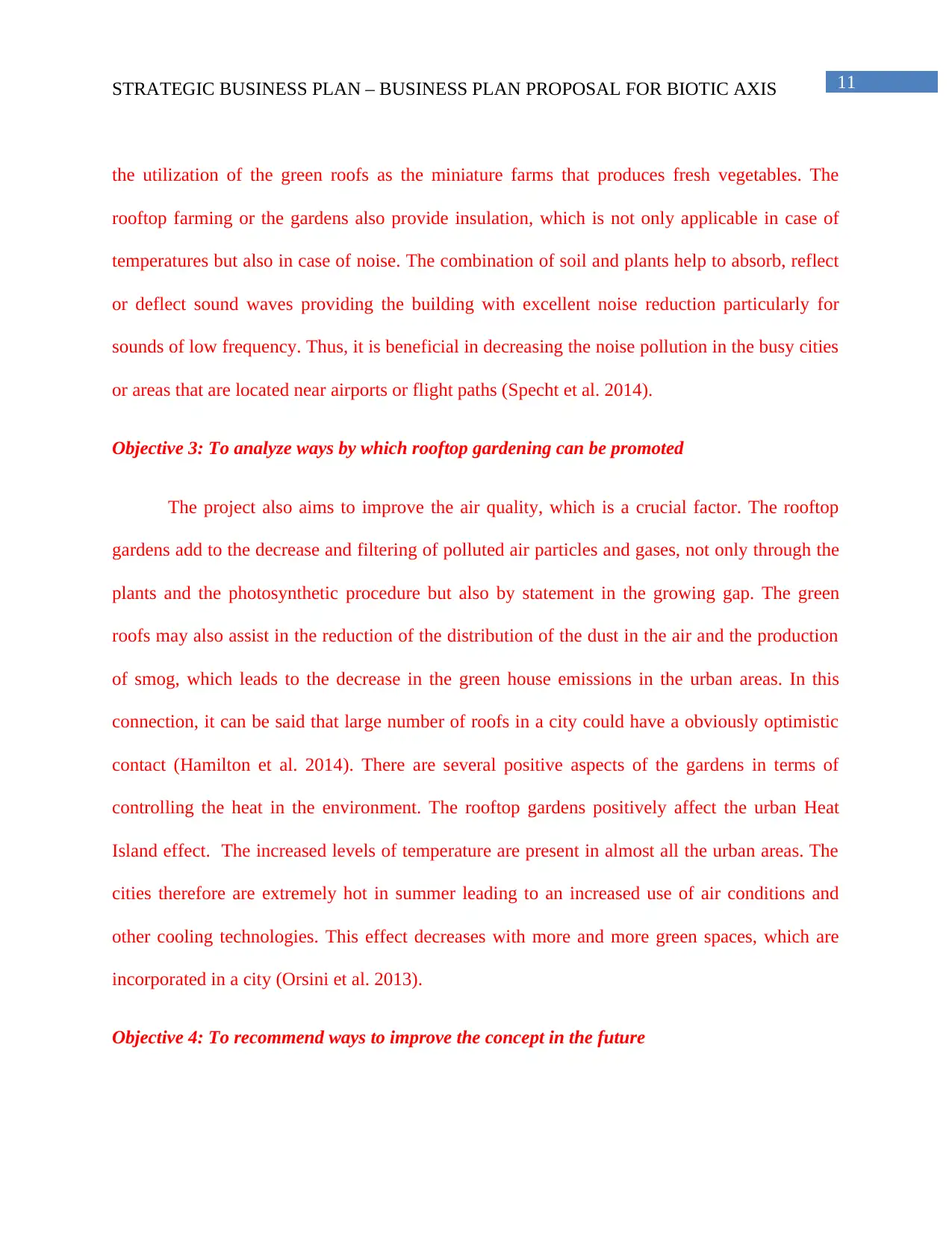
11STRATEGIC BUSINESS PLAN – BUSINESS PLAN PROPOSAL FOR BIOTIC AXIS
the utilization of the green roofs as the miniature farms that produces fresh vegetables. The
rooftop farming or the gardens also provide insulation, which is not only applicable in case of
temperatures but also in case of noise. The combination of soil and plants help to absorb, reflect
or deflect sound waves providing the building with excellent noise reduction particularly for
sounds of low frequency. Thus, it is beneficial in decreasing the noise pollution in the busy cities
or areas that are located near airports or flight paths (Specht et al. 2014).
Objective 3: To analyze ways by which rooftop gardening can be promoted
The project also aims to improve the air quality, which is a crucial factor. The rooftop
gardens add to the decrease and filtering of polluted air particles and gases, not only through the
plants and the photosynthetic procedure but also by statement in the growing gap. The green
roofs may also assist in the reduction of the distribution of the dust in the air and the production
of smog, which leads to the decrease in the green house emissions in the urban areas. In this
connection, it can be said that large number of roofs in a city could have a obviously optimistic
contact (Hamilton et al. 2014). There are several positive aspects of the gardens in terms of
controlling the heat in the environment. The rooftop gardens positively affect the urban Heat
Island effect. The increased levels of temperature are present in almost all the urban areas. The
cities therefore are extremely hot in summer leading to an increased use of air conditions and
other cooling technologies. This effect decreases with more and more green spaces, which are
incorporated in a city (Orsini et al. 2013).
Objective 4: To recommend ways to improve the concept in the future
the utilization of the green roofs as the miniature farms that produces fresh vegetables. The
rooftop farming or the gardens also provide insulation, which is not only applicable in case of
temperatures but also in case of noise. The combination of soil and plants help to absorb, reflect
or deflect sound waves providing the building with excellent noise reduction particularly for
sounds of low frequency. Thus, it is beneficial in decreasing the noise pollution in the busy cities
or areas that are located near airports or flight paths (Specht et al. 2014).
Objective 3: To analyze ways by which rooftop gardening can be promoted
The project also aims to improve the air quality, which is a crucial factor. The rooftop
gardens add to the decrease and filtering of polluted air particles and gases, not only through the
plants and the photosynthetic procedure but also by statement in the growing gap. The green
roofs may also assist in the reduction of the distribution of the dust in the air and the production
of smog, which leads to the decrease in the green house emissions in the urban areas. In this
connection, it can be said that large number of roofs in a city could have a obviously optimistic
contact (Hamilton et al. 2014). There are several positive aspects of the gardens in terms of
controlling the heat in the environment. The rooftop gardens positively affect the urban Heat
Island effect. The increased levels of temperature are present in almost all the urban areas. The
cities therefore are extremely hot in summer leading to an increased use of air conditions and
other cooling technologies. This effect decreases with more and more green spaces, which are
incorporated in a city (Orsini et al. 2013).
Objective 4: To recommend ways to improve the concept in the future
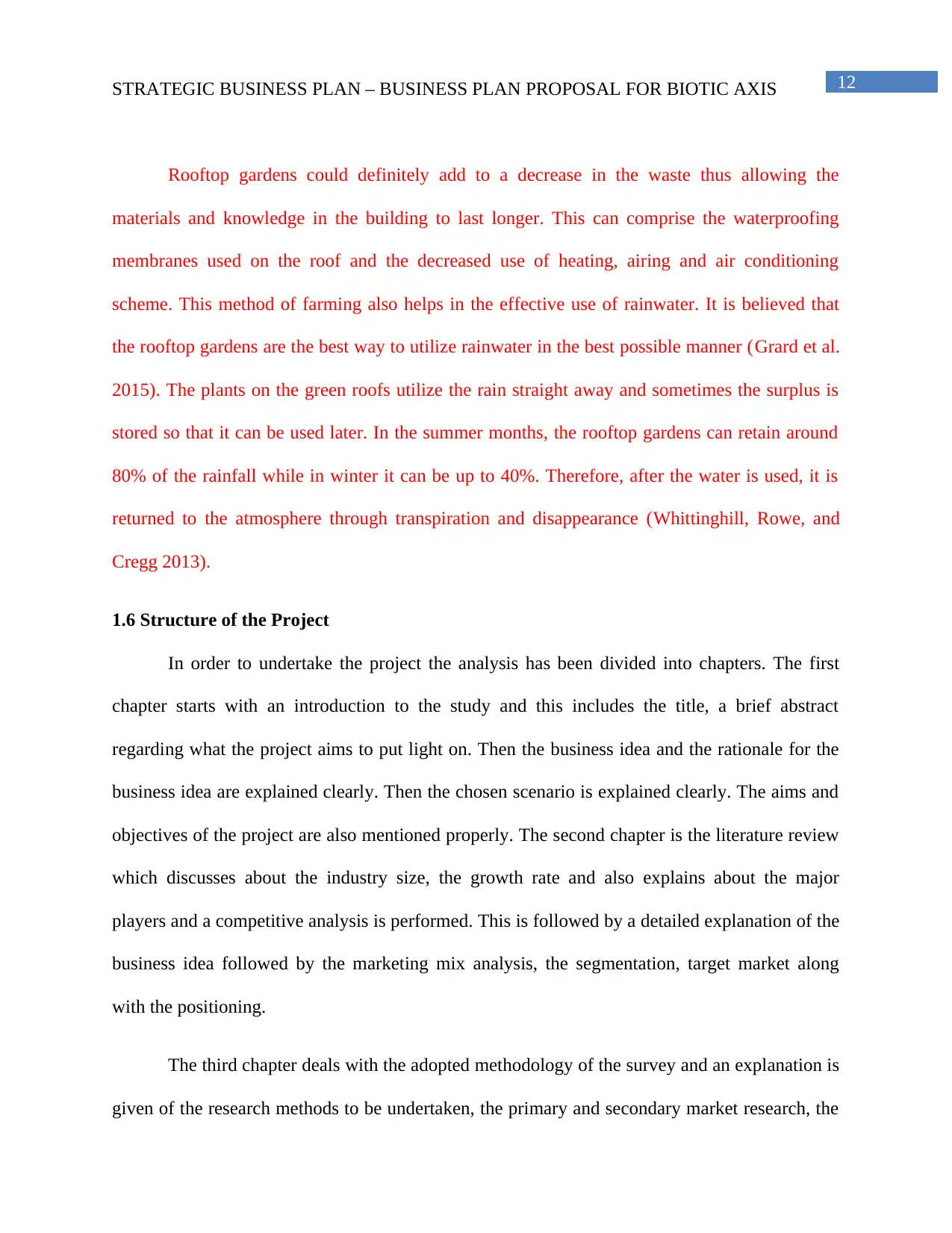
12STRATEGIC BUSINESS PLAN – BUSINESS PLAN PROPOSAL FOR BIOTIC AXIS
Rooftop gardens could definitely add to a decrease in the waste thus allowing the
materials and knowledge in the building to last longer. This can comprise the waterproofing
membranes used on the roof and the decreased use of heating, airing and air conditioning
scheme. This method of farming also helps in the effective use of rainwater. It is believed that
the rooftop gardens are the best way to utilize rainwater in the best possible manner (Grard et al.
2015). The plants on the green roofs utilize the rain straight away and sometimes the surplus is
stored so that it can be used later. In the summer months, the rooftop gardens can retain around
80% of the rainfall while in winter it can be up to 40%. Therefore, after the water is used, it is
returned to the atmosphere through transpiration and disappearance (Whittinghill, Rowe, and
Cregg 2013).
1.6 Structure of the Project
In order to undertake the project the analysis has been divided into chapters. The first
chapter starts with an introduction to the study and this includes the title, a brief abstract
regarding what the project aims to put light on. Then the business idea and the rationale for the
business idea are explained clearly. Then the chosen scenario is explained clearly. The aims and
objectives of the project are also mentioned properly. The second chapter is the literature review
which discusses about the industry size, the growth rate and also explains about the major
players and a competitive analysis is performed. This is followed by a detailed explanation of the
business idea followed by the marketing mix analysis, the segmentation, target market along
with the positioning.
The third chapter deals with the adopted methodology of the survey and an explanation is
given of the research methods to be undertaken, the primary and secondary market research, the
Rooftop gardens could definitely add to a decrease in the waste thus allowing the
materials and knowledge in the building to last longer. This can comprise the waterproofing
membranes used on the roof and the decreased use of heating, airing and air conditioning
scheme. This method of farming also helps in the effective use of rainwater. It is believed that
the rooftop gardens are the best way to utilize rainwater in the best possible manner (Grard et al.
2015). The plants on the green roofs utilize the rain straight away and sometimes the surplus is
stored so that it can be used later. In the summer months, the rooftop gardens can retain around
80% of the rainfall while in winter it can be up to 40%. Therefore, after the water is used, it is
returned to the atmosphere through transpiration and disappearance (Whittinghill, Rowe, and
Cregg 2013).
1.6 Structure of the Project
In order to undertake the project the analysis has been divided into chapters. The first
chapter starts with an introduction to the study and this includes the title, a brief abstract
regarding what the project aims to put light on. Then the business idea and the rationale for the
business idea are explained clearly. Then the chosen scenario is explained clearly. The aims and
objectives of the project are also mentioned properly. The second chapter is the literature review
which discusses about the industry size, the growth rate and also explains about the major
players and a competitive analysis is performed. This is followed by a detailed explanation of the
business idea followed by the marketing mix analysis, the segmentation, target market along
with the positioning.
The third chapter deals with the adopted methodology of the survey and an explanation is
given of the research methods to be undertaken, the primary and secondary market research, the
⊘ This is a preview!⊘
Do you want full access?
Subscribe today to unlock all pages.

Trusted by 1+ million students worldwide
1 out of 94
Related Documents
Your All-in-One AI-Powered Toolkit for Academic Success.
+13062052269
info@desklib.com
Available 24*7 on WhatsApp / Email
![[object Object]](/_next/static/media/star-bottom.7253800d.svg)
Unlock your academic potential
Copyright © 2020–2025 A2Z Services. All Rights Reserved. Developed and managed by ZUCOL.




